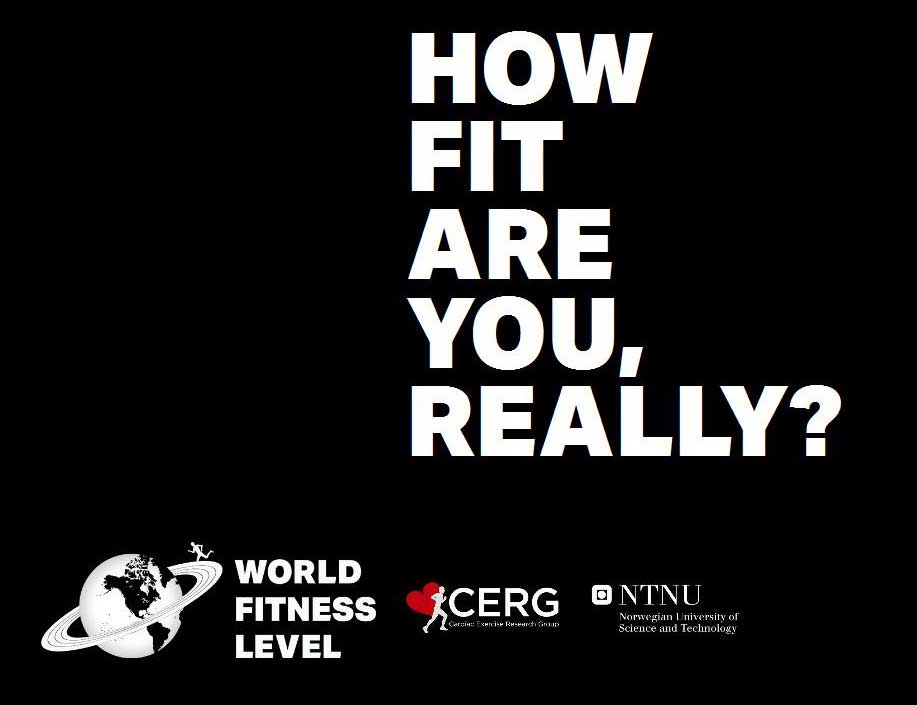Fitness calculator - CERG
The Fitness Calculator
More than seven million individuals all over the world have tried our Fitness Calculator. American health authorities recommend our calculator over other non-exercise models to estimate how fit you really are. You should test your fitness age too, by clicking this link or the image below, but let us first explain what makes our calculator so special and popular.
- The Fitness Calculator is accurate for most people
- The Fitness Calculator predicts premature death
- The Fitness Calculator reveals risk of heart disease
- The Fitness Calculator estimates fitness and health risk if you have atrial fibrillation
- The Fitness Calculator can tell something about risk of cancer
- The Fitness Calculator predicts mental health
- The Fitness Calculator is linked to brain size and dementia
- The Fitness Calculator warns about fatty liver
- The Fitness Calculator is for the whole world
- A new Fitness Calculator estimates fitness more precisely in rheumatoid arthritis
The Fitness Calculator estimates your fitness age measured as maximum oxygen uptake (VO2max). VO2max is the most precise measure of overall cardiovascular fitness. You can also find your own risk of dying early from cardiovascular disease, and we give you some ideas on how you can reduce the risk.
Estimates fitness accurately
In 2007 and 2008, several thousand Norwegians tested their VO2max on a treadmill in The HUNT Fitness Study. They also answered several questions and had a complete health check-up as part of the third HUNT study (HUNT3).
Therefore, we could establish the most important factors for fitness among healthy women and men. These factors – namely age, waist circumference or body mass index (BMI), leisure-time physical activity and resting heart rate – are those included in the algorithm that constitutes our Fitness Calculator.
Later, we showed that The Fitness Calculator is even more accurate in older adults if we add simple measures of lung function to the model. However, the current calculator is accurate enough for all age groups, and we have not included the lung function measurements in the formula. The study was based on our large Generation 100 study, and included direct measurements of VO2max and lung function in almost 1500 older adults.
Reveals your risk
After we made The Fitness Calculator, we showed that the estimated fitness number is of great importance for how long you can expect to live. That's why we now recommend every physician to use the calculator to identify patients with high risk of lifestyle diseases and early death. We still use The Fitness Calculator in much of our research, and each study makes us even more convinced that the calculator is a very useful tool to prevent lifestyle diseases.
Predicts early death
By use of the Fitness Calculator, we estimated fitness in 37,000 healthy individuals who participated in the HUNT1 study in the 1980s. We then followed them for 24 years and looked at health outcomes. The risk of dying from cardiovascular disease was 21% lower for each increase of 3.5 mL/kg/min, or 1 MET. This associations persisted after adjusting the analysis for confounding factors. The risk of dying from all causes during follow-up was also gradually reduced with better fitness.
Moreover, the number you get from The Fitness Calculator seems to be all you really need to estimate the risk of cardiovascular disease and premature death in presumably healthy individuals. We studied this in almost 40,000 participants from the HUNT study who were followed for up to 17 years. The calculator estimated the risk about just as good on its own as when traditional risk factors for cardiovascular disease are included in the model.
Predicts heart attack
The Fitness Calculator doesn't only predict risk of early death. It also predicts a heart attack in middle-aged and older individuals. We followed 26,000 healthy women and men for 13 years, and for each 1 MET increased fitness, the risk of an acute heart attack was 11% lower in women and 3% lower in men.
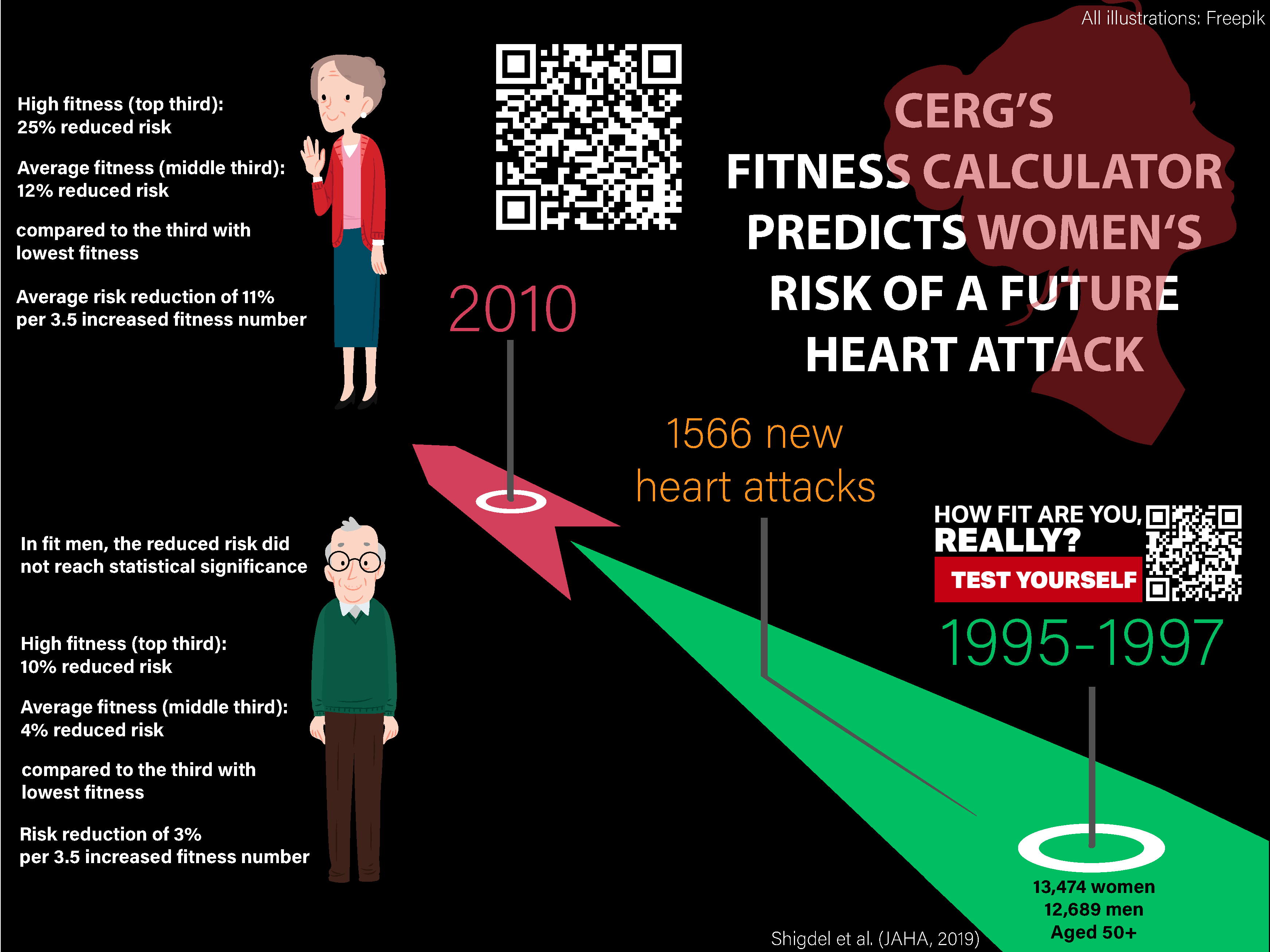
Predicts heart surgery
In addition, we have shown that you have a lower risk heart surgery, the higher fitness you achieve with the Fitness Calculator. In this study, we followed more than 45,000 people for approximately 20 years, and showed that the risk of coronary artery bypass grafting was 11% lower for each increase of 3.5 fitness numbers.
The same study also links high fitness to increased probability of a long life after heart surgery. For every 3.5 fitness increase, the risk of premature death after heart surgery decreased by 15%.
The risk of aortic valve replacement surgery is also reduced with high fitness. Among over 57,000 participants in HUNT2 and/or HUNT3, the risk of developing aortic stenosis requiring surgery over the next few decades was reduced by 15% for every 1 MET increase in estimated cardiorespiratory fitness. The fittest 20% had a 56% lower risk of surgery than the 20% with the worst estimated fitness.
Here, too, the chance of long-term survival following surgery was higher with better fitness. Each increase of 1 MET reduced the risk of early death after aortic valve surgery by 37%.
Reveals the risk of atrial fibrillation
We have also published results that link better estimated fitness to lower risk of atrial fibrillation. In women, each increase of 1 MET was associated with 16% reduced risk, whereas the corresponding risk reduction was 5% in men. Even increasing fitness over time seems to be beneficial to reduce the risk of atrial fibrillation. The results are based on data from 40,000 women and men who participated in HUNT3, of which 22,000 also had taken part in HUNT2 eleven years earlier.
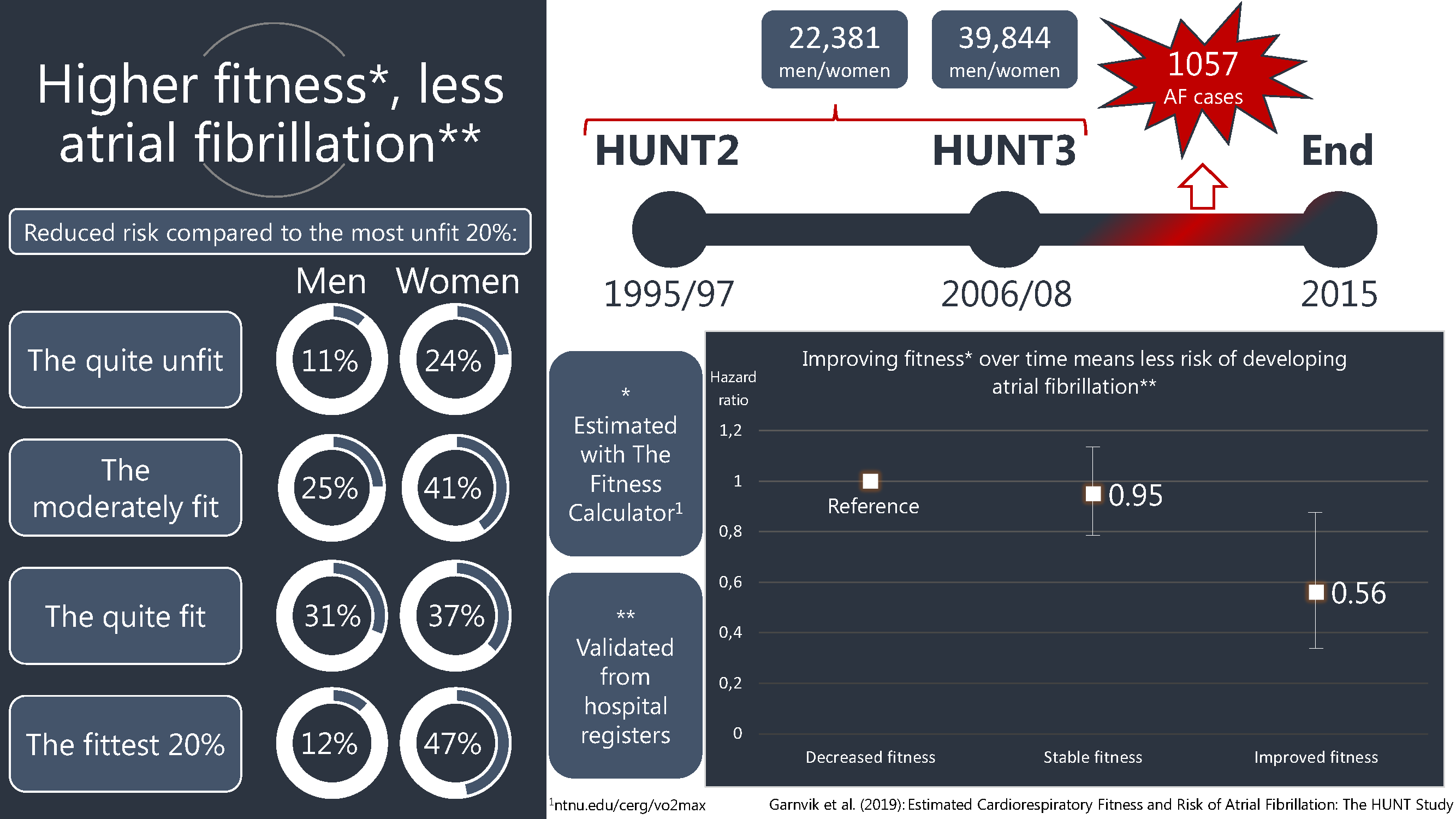
Accurate and useful also in atrial fibrillation
We have also confirmed that the Fitness Calculator estimates fitness accurately in persons with established atrial fibrillation. During the HUNT4 Fitness Study, 652 men and women with atrial fibrillation performed a maximum oxygen uptake test, and we used this sample to validate the Fitness Calculator in this group of patients. In men, the calculator overestimated true fitness by on average 2.5 fitness numbers, whereas the difference was only 0.2 in women.
The main results of that research paper show that persons with established atrial fibrillation are at lower risk of early death and cardiovascular events the higher they score on the Fitness Calculator. The 25% with the highest age-ajusted fitness had 30–40% lower risk than those with the lowest estimated fitness. For each increase of 1MET, the health risk decreased by 12–15%. The study includes a total of 1117 men and women with confirmed atrial fibrillation, and we followed them for up to nine years.
Predicts cancer
The fitness calculator is also suitable for assessing cancer risk. Almost 8,000 of the approximately 47,000 included participants from HUNT2 developed cancer by the end of 2018. After the analyzes had been adjusted for other differences between those who scored high and low on the Fitness Calculator, it turned out that the cancer risk was 15% lower for the fittest third than for the third with lowest fitness for age.
Almost 1,400 of the cancer cases among men were prostate cancer, while close to 900 women got breast cancer during the follow-up period. The results showed a trend of an association between high fitness and a 15% reduced risk of prostate cancer, while there was no definite link between fitness level and breast cancer.
Less depression
Medium and high estimated fitness also predicts lower likelihood of having depression, as well as lower risk of getting depressed. The third of 26,000 middle-aged and older HUNT2 participants with the lowest fitness levels had 26% higher odds of having depression compared to the fittest third. Among 14,000 individuals who also participated in HUNT3 eleven years later, the risk of getting depression between the two surveys was reduced with around 20% in those with medium or high estimated fitness at HUNT2.
Moreover, we have shown that persons who maintain high estimated fitness and report low symptoms of depression over time have lower risk of dying during follow-up than those with low fitness and more depressive symptoms. The study is based on information from more than 15,000 middle-aged women and men from the HUNT2 and HUNT3 studies.
Larger brain, less dementia
Those who maintain high fitness and those who improve their fitness have a 40-50% reduced risk of getting dementia compared to those who have poor fitness over time. Also, high fitness is linked to significantly reduced risk of dying from or with dementia. We have followed more than 30,000 men and women for up to 30 years, and estimated their fitness in both the 1980s and 1990s. The risk of dementia was 16% lower for every 1 MET age-adjusted increase in fitness between the two surveys.
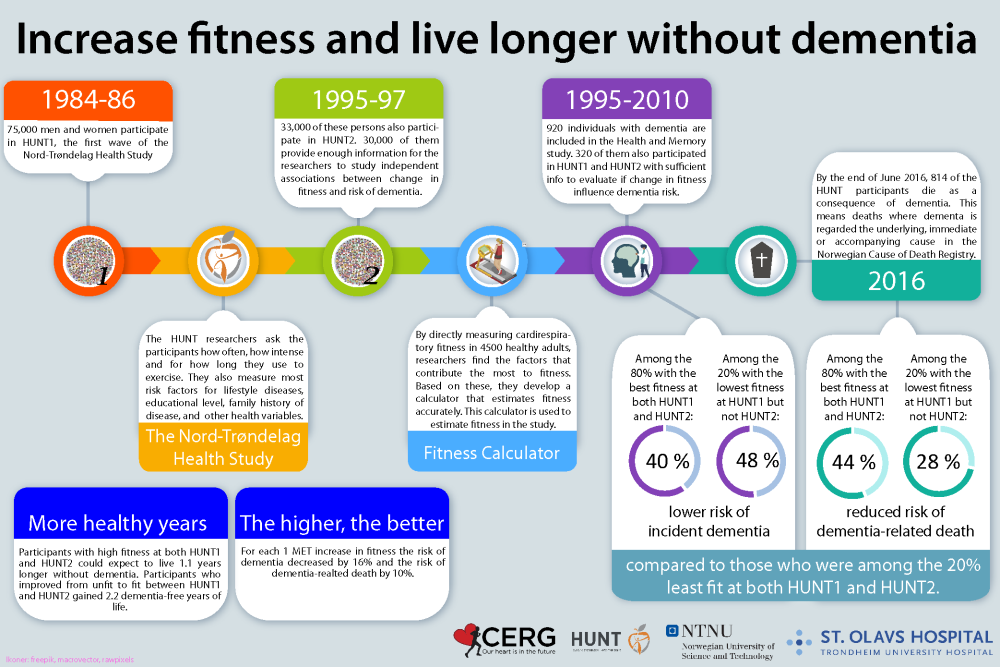
Improved estimated fitness over time is also linked to higher brain volumes in middle-aged persons. 751 men and women aged between 50 and 67 years had their brains scanned as part of the HUNT3 study. The same persons also participated in the HUNT2 study eleven years earlier, and those who maintained high fitness or improved from low to high between the two surveys had bigger brains than those who stayed unfit.
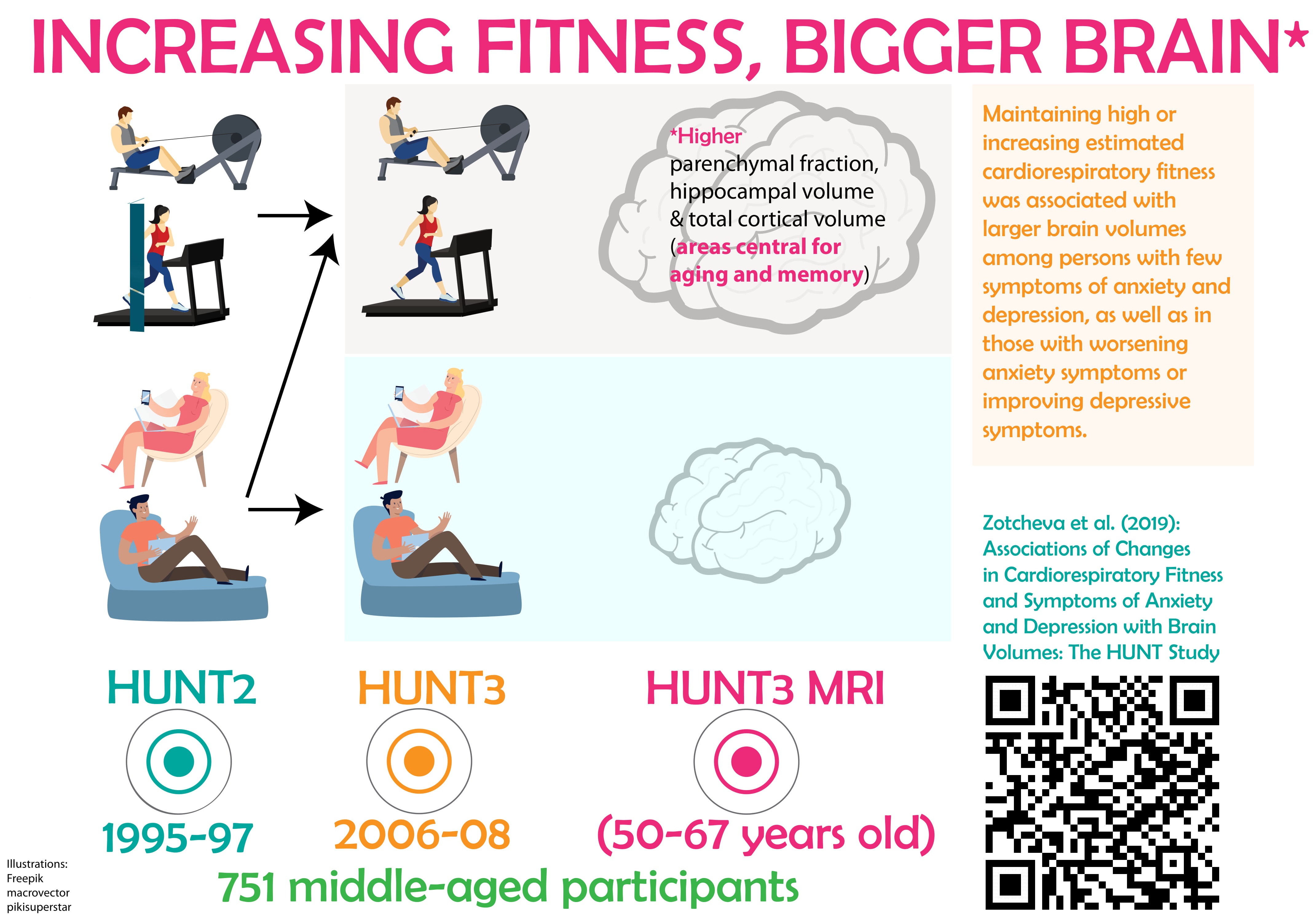
Predicts risk in fatty liver disease
Another study shows that individuals with low estimated fitness have several-fold increased likelihood of non-alcoholic fatty liver disease. We found that the 20% with the lowest fitness had 17 times the odds compared to the 40 % with the highest fitness, even among individuals who sat less than four hours a day. Furthermore, among the 36% who had non-alcoholic fatty liver disease in our cohort, the risk of dying within the next nine years was 50% higher in those with low fitness according to The Fitness Calculator.
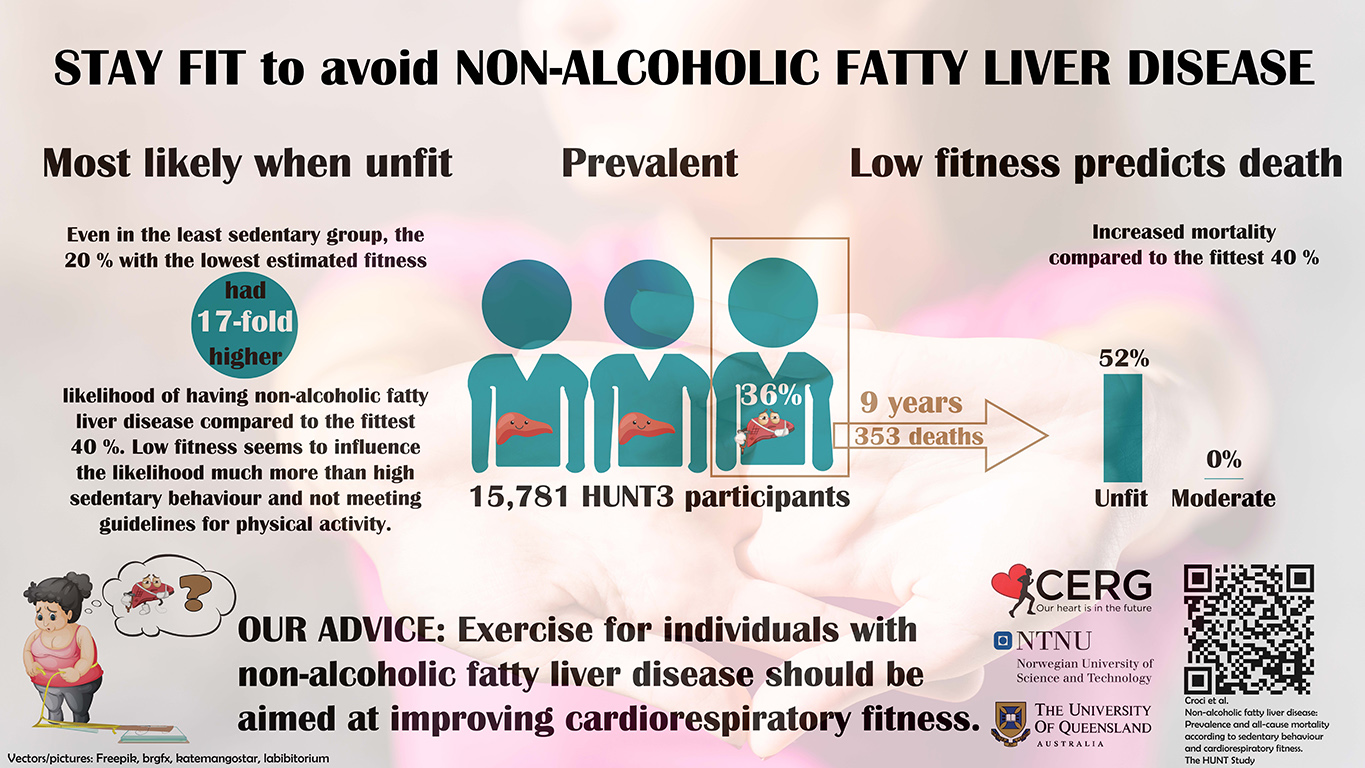
Unique database for the whole world
Answers from more than 730,000 healthy persons have made it possible for us to create a database on the fitness levels for people in different countries and on all continents. The database could – in combination with the Fitness Calculator – potentially be used by health services in all countries to identify population groups and individual patients with especially high risk of cardiovascular disease and other non-communicable diseases.
Some results from the database:
- The average man in the world has a fitness number of 50.4
- The average woman in the world has a fitness number of 40.6
- The average man sits 7.2 hours a day
- The average woman sits 6.8 hours a day
- Regular physical activity eliminates the increased risk associated with a sedentary lifestyle: Even among those who reported to sit a lot, individuals who reported to exercise according to guidelines had significantly higher estimated VO2max than individuals who did not.
- VO2max is lower the older you are.
Read the full research article:
Global Fitness Levels: Findings From a Web-Based Surveillance Report
The Rheumatoid Arthritis Fitness Calculator
Our Fitness Calculator is not as accurate for men and women with rheumatoid arthritis as for most people. Therefore, we have contributed to a new fitness formula based on maximum oxygen uptake tests of 93 persons with rheumatoid arthritis.
More accurate
The new formula estimates fitness far better in this group of patients than the original Fitness Calculator – especially in those with low fitness. We recommend health professionals to use the new calculator to assess fitness in persons with rheumatoid arthritis and to motivate these patients to become more physically active.
Try the new Fitness Calculator for rheumatoid arthritis
To use the calculator, you need information on disease activity over the past week. However, we have also made an alternative formula that can be used in case you don't have that information. This formula is available in the abstract of the research paper.
Decreases faster
Estimated cardiorespiratory fitness is reduced to begin with and also decreases faster in people with rheumatoid arthritis than in the general population. During the eleven years between the second and third HUNT Study, estimated cardiorespiratory fitness decreased by 8.3 ml/kg/min for the participants with rheumatoid arthritis, compared to 6.7 ml/kg/min for people of the same age from the general population.
Linked to increased mortality
The disease-specitic Fitness Calculator a good indication of life expectancy in patients with rheumatoid arthritis: Lower fitness means higher risk of premature death. People with rheumatoid arthritis have lower estimated cardiorespiratory fitness than average for their gender and age, and the low average fitness levels largely explains why these patients generally live shorter than most people.
Frequently Asked Questions
How do I measure my resting heart rate?
How do I measure my resting heart rate?
To measure your resting heart rate, you can either use a heart rate monitor and sit quietly for ten minutes, and use the lowest pulse measurement you get. Or you can simply sit quietly for ten minutes, then measure your pulse by counting it for 30 seconds and multiplying by two.
How do I measure my waist circumference?
How do I measure my waist circumference?
To measure your waistline, use a measuring tape around your waist at the level of your navel.
What does my fitness number tell me?
What does my fitness number tell me?
Physical fitness is very important for longevity and good health. The maximal oxygen uptake (fitness) is the most precise measure of overall cardiovascular fitness. Read more about the importance of good fitness here, and find out what are the normal values for people your own age.
How can I improve my results the next time I try the Fitness Calculator?
How can I improve my results the next time I try the Fitness Calculator?
Here we have gathered some general exercise advice. You could also try our 7 week fitness program, which is a fast and effective way to get fit.
What do we ask for in the Fitness Calculator, and why?
Where are you from? Ethnicity? Highest level of education?
Where are you from? Ethnicity? Highest level of education?
We use this information only for research purposes, so we can compare fitness levels in different coutries, and among different ethnicities. Nothing of this is used in the algorithm.
Gender, age, height, weight?
Gender, age, height, weight?
Women's fitness values tend to be about 20% lower than men's, so gender matters a lot. Age is also important, and the older you are, the lower the oxygen uptake. We use height and weight to calculate body mass index (BMI), which also goes into the algorithm.
What’s your maximum heart rate?
What’s your maximum heart rate?
Maximum heart rate is a common means of denoting intensity for endurance training. If you don't know your maximum heart rate, our HRmax Calculator (integrated in the Fitness Calculator) can estimate it for you.
How often, how long, and how intense is your exercise?
How often, how long, and how intense is your exercise?
All these factors matter in a balanced way, but exercise intensity is the most indicative of fitness.
What’s your waistline? What’s your resting pulse?
What’s your waistline? What’s your resting pulse?
Both waist circumference and BMI can be used in the algoritm. The Fitness Calculator will be about just as accurate independently of which body composition measurement is used.
A low resting heart rate is a sign of a fit heart, and world-class endurance athletes use it to see if they’re ready for their next exercise session.
Heart Rate Calculator
List of scientific publications on The Fitness Calculator:
2025:
Nauman, J., Ingeström, E. M., Tari, A. R., & Wisløff, U. (2025). Running from Death: Can Fitness Outpace Alcohol’s Harm? Changes in Alcohol Intake, Fitness and All-Cause Mortality in the HUNT Study, Norway Sports Medicine, 1-11.
2024:
Sagelv, E. H., Casolo, A., Eggen, A. E., Heitmann, K. A., Johansen, K. R., Løchen, M. L., Mathiesen, E. B., Morseth, B., Njølstad, I., Osborne, J. O., Hagerupsen, K., Pedersen, S., & Wilsgaard, T. (2024). Females Display Lower Risk of Myocardial Infarction From Higher Estimated Cardiorespiratory Fitness Than Males: The Tromsø Study 1994-2014. Mayo Clinic Proceedings: Innovations, Quality & Outcomes, 8(1), 62-73.
Øvretveit, K., Ingeström, E. M., Spitieris, M., Tragante, V., Thomas, L. F., Steinsland, I., Brumpton, B. M., Gudbjartsson, D. F., Holm, H., Stefansson, K., Wisløff, U., & Hveem, K. (2024). Polygenic Interactions With Environmental Exposures in Blood Pressure Regulation: The HUNT Study. Journal of the American Heart Association, e034612.
2023:
Nystøyl, B. T. S., Letnes, J. M., Nes, B. M., Slagsvold, K. H., Wisløff, U., & Wahba, A. (2023). Cardiorespiratory fitness and the incidence of surgery for aortic valve stenosis–The HUNT study. European Journal of Cardio-Thoracic Surgery, ezad322
Havnen, A., Zotcheva, E., Bjerkeset, O., Sui, X., & Ernstsen, L. (2023). Cardiorespiratory fitness and incident use of anxiolytics and antidepressants in adults. A linkage study between HUNT and the Norwegian Prescription Database. Journal of Affective Disorders.
Houge, I. S., Hoff, M., & Videm, V. (2023). The association between rheumatoid arthritis and reduced estimated cardiorespiratory fitness is mediated by physical symptoms and negative emotions: a cross-sectional study. Clinical Rheumatology, 1-10.
Wang, J., Mai, X. M., & Sun, Y. Q. (2023). Estimated cardiorespiratory fitness in relation to overall, breast and prostate cancer incidence: the Norwegian HUNT study. Annals of Epidemiology, 77, 103-109.
2022:
Ernstsen, L., Zotcheva, E., Sui, X., Engstrøm, M., Martínez-Velilla, N., Bjerkeset, O., Bjorvatn, B., & Havnen, A. (2022, October). Association Between Cardiorespiratory Fitness and Incident Purchase of Hypnotic Drugs in Adults: The HUNT Study. In Mayo Clinic Proceedings. Elsevier.
Smenes, B. T., Nes, B. M., Letnes, J. M., Slagsvold, K. H., Wisløff, U., Wahba, A. (2022). Cardiorespiratory fitness and the incidence of coronary surgery and postoperative mortality: the HUNT study. European Journal of Cardio-Thoracic Surgery
2021:
Liff, M. H., Hoff, M., Wisløff, U., & Videm, V. (2021). Reduced cardiorespiratory fitness is a mediator of excess all-cause mortality in rheumatoid arthritis: the Trøndelag Health Study. RMD Open, 7(1):e001545
2020:
Liff, M. H., Hoff, M., Wisløff, U., & Videm, V. (2020). Faster age-related decline in cardiorespiratory fitness in rheumatoid arthritis patients: an observational study in the Trøndelag Health Study. Rheumatology International, 1-11.
Garnvik, L. E., Malmo, V., Jansky, I., Ellekjær, H., Wisløff, U., Loennechen, J. P., & Nes, B. (2020). Physical activity, cardiorespiratory fitness, and cardiovascular outcomes in individuals with atrial fibrillation: the HUNT study. European Heart Journal. ehaa032
Liff, M. H., Hoff, M., Fremo, T., Wisløff, U., & Videm, V. (2020). An Estimation Model for Cardiorespiratory Fitness in Adults with Rheumatoid Arthritis. Medicine & Science in Sports & Exercise
2019:
Tari, A. R., Nauman, J., Zisko, N., Skjellegrind, H. K., Bosnes, I., Bergh, S., Stensvold, D., Selbæk, G., & Wisløff, U. (2019). Temporal changes in cardiorespiratory fitness and risk of dementia incidence and mortality: a population-based prospective cohort study. The Lancet Public Health, 4(11), e565-e574.
Garnvik, L. E., Malmo, V., Janszky, I., Wisløff, U., Loennechen, J. P., & Nes, B. M. (2019). Estimated Cardiorespiratory Fitness and Risk of Atrial Fibrillation: The HUNT Study. Medicine and science in sports and exercise.
Shigdel, R., Dalen, H., Sui, X., Lavie, C. J., Wisløff, U., & Ernstsen, L. (2019). Cardiorespiratory fitness and the risk of first acute myocardial infarction: the HUNT Study. Journal of the American Heart Association, 8(9), e010293.
Shigdel, R., Stubbs, B., Sui, X., & Ernstsen, L. (2019). Cross-sectional and longitudinal association of non-exercise estimated cardiorespiratory fitness with depression and anxiety in the general population: The HUNT study. Journal of affective disorders, 252, 122-129.
Zotcheva, E., Pintzka, C. W. S., Salvesen, Ø., Selbæk, G., Håberg, A. K., & Ernstsen, L. (2019). Associations of Changes in Cardiorespiratory Fitness and Symptoms of Anxiety and Depression with Brain Volumes: The HUNT Study. Frontiers in Behavioral Neuroscience, 13, 53.
Croci, I., Coombes, J., Sandbakk, S. B., Keating, S. E., Nauman, J., Macdonald, G. A., & Wisløff, U. (2019). Non-alcoholic fatty liver disease: prevalence and all-cause mortality according to sedentary behaviour and cardiorespiratory fitness. The HUNT Study Progress in Cardiovascular Diseases.
2018:
Carlsen, T., Salvesen, Ø., Sui, X., Lavie, C. J., Blair, S. N., Wisløff, U., & Ernstsen, L. (2018). Long-term Changes in Depressive Symptoms and Estimated Cardiorespiratory Fitness and Risk of All-Cause Mortality: The Nord-Trøndelag Health Study. Mayo Clinic Proceedings.
2017:
Hassel, E., Stensvold, D., Halvorsen, T., Wisløff, U., Langhammer, A., & Steinshamn, S. (2017). Lung function parameters improve prediction of VO2peak in an elderly population: The Generation 100 study. PloS one, 12(3), e0174058.
Nauman, J., Tauschek, L. C., Kaminsky, L. A., Nes, B. M., & Wisløff, U. (2017). Global fitness levels: findings from a Web-based surveillance report. Progress in Cardiovascular Diseases.
2016:
Nauman, J., Nes, B. M., Lavie, C. J., Jackson, A. S., Sui, X., Coombes, J. S., Blair, S. N., & Wisløff, U. (2017, February). Prediction of cardiovascular mortality by estimated cardiorespiratory fitness independent of traditional risk factors: the HUNT study. In Mayo Clinic Proceedings (Vol. 92, No. 2, pp. 218-227). Elsevier.
2015:
Nauman, J., Stensvold, D., Coombes, J. S., & Wisløff, U. (2016). Cardiorespiratory Fitness, Sedentary Time, and Cardiovascular Risk Factor Clustering. Medicine and science in sports and exercise, 48(4), 625-632.
2014:
Nes, B. M., Vatten, L. J., Nauman, J., Janszky, I., & Wisløff, U. (2014). A simple nonexercise model of cardiorespiratory fitness predicts long-term mortality. Medicine and science in sports and exercise, 46(6), 1159-1165.
2011:
Nes, B. M., Janszky, I., Vatten, L. J., Nilsen, T. I. L., Aspenes, S. T., & Wisløff, U. (2011). Estimating V˙O2peak from a nonexercise prediction model: the HUNT study, Norway. Medicine & Science in Sports & Exercise, 43(11), 2024-2030.
Send us an e-mail:
cerg-post@mh.ntnu.no
Send us regular mail:
NTNU, Fakultet for medisin og helsevitenskap
Institutt for sirkulasjon og bildediagnostikk
Postboks 8905
7491 Trondheim
Visit us:
St. Olavs Hospital
Prinsesse Kristinas gt. 3
Akutten og Hjerte-lunge-senteret, 3. etg.
7006 Trondheim


